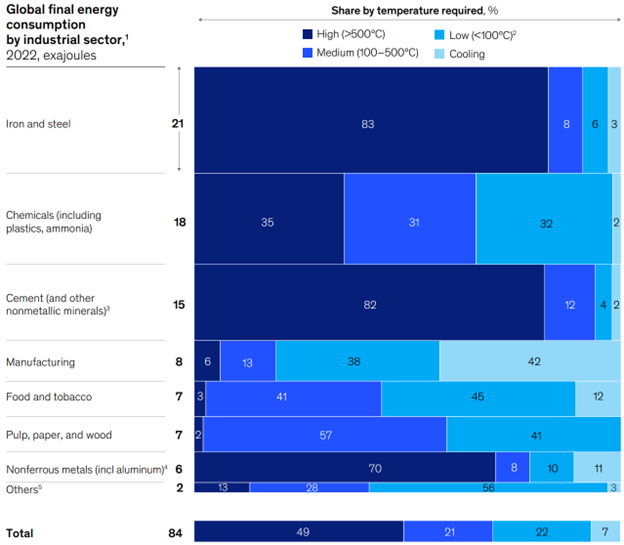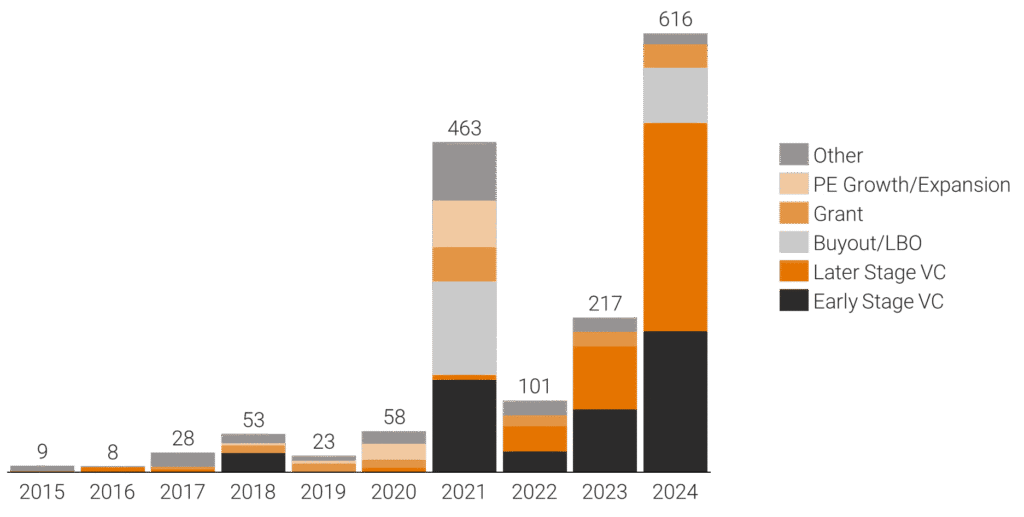DOWNLOAD
Submit the form below to continue your download
SUCCESS
Your download will begin shortly, if it does not start automatically, click the button below to download now.
DownloadIndustrial Decarbonization: How Thermal Storage Can Electrify Heat at Scale
Expert View By Meng Lei

Meng Lei
VP, Investment Team
Delivering cost-effective solutions for industrial heat decarbonization is critical to achieving deep reductions in global emissions. Process heat accounts for roughly 55 percent of industrial energy use and about 20 percent of global final energy demand (McKinsey). Roughly half of U.S. industrial heat demand is below 400°C, while sectors such as iron and steel, chemicals, and cement rely on medium- to high-temperature processes above 500°C. Fuel costs are a major determinant of competitiveness for these industries. In the United States, natural gas has long provided a low-cost energy source for this heat, limiting the economic incentive to electrify and slowing progress toward decarbonization. This market is now beginning to open up.
The rapid growth of renewable generation has created regular periods of cheap, abundant electricity across many regions, and those moments are only growing more frequent each year. At the same time, rising power demand from data centers and electrification elsewhere is straining the grid, heightening the need for resources that can balance supply and demand. Thermal energy storage (TES) is primed for this very opportunity: the technology converts clean but variable electricity into reliable, 24/7 industrial heat, effectively turning heavy industrial loads into grid-balancing assets.
By selectively charging when power is most abundant, thermal batteries have the potential to ease grid constraints while decarbonizing manufacturing at cost parity with fossil fuels. This combination of grid flexibility and industrial decarbonization makes TES one of the most compelling and highest-impact opportunities in the clean energy transition.

From labs to industries: technical and commercial readiness
Success for thermal storage depends on the interplay between system performance, power price dynamics, and industrial demand for resilient, cost-competitive heat. Those conditions are now beginning to align in ways that make large-scale deployment viable.
Thermal batteries store and deliver heat efficiently for hours to days across a broad temperature range, from as low as 100°C to over 1,500°C. Technology providers are advancing multiple approaches to deliver cost-effective heat, from molten-salt systems to solid-state thermal batteries using graphite or ceramics. These systems are achieving round-trip efficiencies of 90 to 98 percent (link), and companies such as Antora and Rondo can store energy up to 2,400°C and 1,000°C respectively (link, link). With pilot, demonstration, and early commercial systems now operating across a diverse range of temperatures and materials, the sector is building a robust evidence base that validates the technical reliability of TES.
Commercially, thermal storage is progressing towards unsubsidized cost parity with fossil alternatives in selected markets as the technology matures and manufacturing scales. In regions with abundant renewables and low marginal power prices at peak generation, TES is projected to deliver completely unsubsidized heat below $6 per MMBtu by 2030 (Brattle). However, cost-competitiveness for thermal storage requires that the system can access either behind-the-meter renewable supply or modern electricity rate designs that recognize the value of flexible load.
These economics are highly dependent on geography and access to low-cost, intermittent power, but demonstrate that TES is moving steadily toward direct cost competitiveness under the right conditions.
Market design: supportive frameworks for thermal storage
The emerging economic viability of TES underscores the importance of policy and market structures that can accelerate deployment, drive long-term cost reduction, and expand where the technology can displace fossil gas.
Carbon-pricing mechanisms such as California’s Cap and Trade and Low Carbon Fuel Standard (LCFS) and the EU Emissions Trading System (ETS) directly improve TES economics by internalizing the cost of emissions and levying costs on fossil alternatives. Funded by ETS revenues, the EU has also launched a €1 billion auction to support thermal storage and other technologies targeting industrial electrification (European Commission).
Beyond direct emissions frameworks, regulators are modernizing power markets to better recognize the grid value of flexible industrial loads. At the federal level, FERC is evaluating large-load interconnection policies and considering how to better value flexibility. To unlock thermal storage, thermal energy storages purchases of electricity for resale as heat or power should be considered wholesale transactions. At the state and local level, utilities in places like South Dakota, North Dakota, Minnesota, and Vermont have introduced rate structures that value controllable industrial loads and facilitate access to low-cost, off-peak power (Brattle).
While these reforms remain geographically uneven since they typically sit at the state and service territory level, together they signal growing recognition of TES as a grid-enhancing demand resource that supports both industrial electrification and system flexibility. With steady improvement in market design and policy support, the next challenge is ensuring that capital can match this momentum.
From venture to infrastructure: how capital is meeting the moment
Investment in thermal energy storage has accelerated in recent years as technical progress and customer demand have improved project bankability. Since 2020, sector funding has grown and shifted toward later-stage investors, reflecting greater confidence in TES’s readiness for commercial deployment (Pitchbook).After years of R&D, proven demonstration performance, and rising industrial interest, the sector is now commissioning early commercial-scale systems. In the past month alone, both Rondo and Kyoto Group have commissioned industrial-scale plants, and Pantokrator has indicated that 10+ projects are projected to come online in the next 12 months (Rondo, Kyoto Group, Pantokrator). These projects collectively signal that TES has entered a phase of commercialization.
Each of these initial projects reduces risk for the sector, establishes performance benchmarks, and broadens the universe of investors ready to participate in TES as an emerging class of infrastructure investment. Together, they signal that the sector has moved beyond demonstration and is entering a capital-intensive phase where infrastructure investors will be essential to finance scale and replication.
Thermal energy storage investment by category ($M)

A new dimension of U.S. manufacturing capability
The first wave of investment in thermal storage is beginning to translate into tangible domestic manufacturing capacity. A leading example is Antora Energy’s 50,000-square-foot manufacturing facility in San Jose, California which is already supplying its initial commercial projects and creating hundreds of U.S. skilled jobs. As Antora scales production to meet growing demand for its thermal batteries, it demonstrates how investment in TES catalyzes localized industrial activity and strengthens the domestic manufacturing base.
Factory-built, modular systems shorten project lead times, reduce installed costs, and reinforce the clean-energy supply chain emerging across the country. As production capacity expands, scale will support economics and further accelerate deployment. Decarbonizing industrial heat is becoming a reality.
More insights
Industrial Decarbonization: How Thermal Storage Can Electrify Heat at Scale
Investment in thermal energy storage has accelerated in recent years as technical progress and customer demand have improved project bankability. Since 2020, sector funding has grown and shifted toward later-stage investors, reflecting greater confidence in TES’s readiness for commercial deployment.
Read moreConsolidation: The Pathway to Enduring Impact
It is easy to be disoriented by the swing from exuberance to pessimism that has defined the clean energy sector in recent years. Yet these moments are precisely when opportunity is greatest. Beneath the headlines are clear indicators of tremendous potential in the U.S. energy transition. The challenge is to separate fundamentals from sentiment, to acknowledge and fix the mistakes that we have made, and to chart a path to scale rooted in discipline, operational excellence, and commercial reality.
Read moreMeeting load growth with clean, flexible power
In the wake of the One Big Beautiful Bill, load growth remains a clear and steady tailwind for renewable energy. Renewables remain the cheapest source of power and the quickest to install, ensuring a bright outlook for the industry despite the shortened available window for some tax incentives. Over the last twenty years, annual investment in renewable energy in the U.S. increased from $5 billion to $100 billion (BloombergNEF, 1H 2025 Renewable Energy Investment Tracker). Compelling economics and flexible demand has the potential to unlock even greater investment in the sector: powering new load with electricity that would otherwise be wasted boosts project economics, ensures quick access to power, and delivers system-wide benefits.
Read more